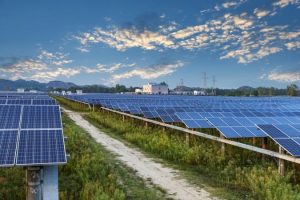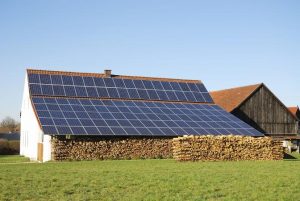Solar energy is a major renewable energy source with the potential to meet many of the challenges facing the world. There are many reasons to promote its share in the energy market. This power source is increasing in popularity because it is versatile with many benefits to people and the environment.
Importance to Environmental Protection
Sunlight received by earth in one hour is enough to meet the annual energy needs of all people worldwide. In 2015 solar energy was the fastest growing energy sector with a 33% rise. The environmental advantages are the main drivers in promoting solar energy.
Solar Is Clean and Safe

Solar is a safe alternative which can replace current fossil fuels like coal and gas for generation of electricity that produce air, water, and land pollution. World Wide Fund For Nature, also known as the World Wildlife Fund (WWF), notes that electricity generation from fossil fuels causes pollution of air leading to acid rain, damaged forest areas, and affected agricultural production leading to loss of billions of dollars worldwide. Nuclear power pollutes water and land and has caused environmental catastrophes. Use of solar energy will eliminate these unsafe, unclean consequences from using conventional fossil fuels.
Prevents Destruction of Habitats
Trees constantly remove and use carbon dioxide from the air to make their food, and this carbon is then stored in them. When forests are cut for mining raw materials for conventional energy, this major carbon sink disappears and also increases climate change. “Nine out of ten animals on land” live in forests, according to WWF, and a loss of habitats diminishes their populations. Switching to solar power is important to keep these habitats intact for the animals who live there as well as continue to keep the air clean.
Combats Climate Change
The carbon emissions lead to a rise in global temperatures, and changes in weather patterns leading to a cascade of effects. Heat waves, and increase in disease-spreading insects cause health problems especially for children and the elderly.
Climate change has lead to increase in flooding and hurricanes due to disturbed weather patterns. Higher carbon dioxide concentration is making oceans acidic and killing marine life, like corals. Higher temperatures result melting of polar ice caps, reducing habitats for wildlife and also increase sea level. This results in submersion and loss of land along the coast, displacing people. Irregular rainfall or increasing droughts affects agriculture and livelihoods of the weaker sections of society globally.
Solar power can restrict climate change as it produces no carbon emissions. The carbon footprint of solar panels can be offset in as quickly as four years’ time.
Global warming has to be curbed to a 1.5 degrees Celsius rise, in accordance to the Paris Agreement of 2015. The U.S. committed to cut down emissions by 26-28% of 2005 levels by 2025. Solar energy is vital to meet these commitments.
Social and Economic Benefits
In early 2016 there was a 43% rise in solar installations, and by the second quarter U.S. had an installed capacity of 31.6 gigawatts (GW) enough to power 6.2 million homes.
Small and Decentralized Electricity Source
Solar energy’s greatest attraction is that it can be produced on a small scale directly by the end consumers in contrast to large centralized conventional energy sources controlled by large corporations.
- Solar energy is suitable for heating and electricity generation using photo-voltaic cells installed on roof-tops of individual buildings. This is useful as decentralized sources of electricity for households and commercial businesses. Solar water heating and passive solar designing of buildings to cool or heat space are other solar technologies available for individual buildings according to National Renewable Energy Laboratory.
Medium-sized systems for community level power generation are also becoming popular. 13 states in U.S. installed 100 megawatts (MW) in 2015 alone, and residential units reached 2 gig watts. Community solar installations of 100 MW were installed between 2010-2015. These installations are important to keep communities running at a lower cost for everyone.

In addition, on a large scale “Solar thermal/electric power plants generate electricity by concentrating solar energy to heat a fluid and produce steam that is then used to power a generator”.
- The decentralized nature of solar power makes it a practical and viable energy source in remote areas located far from the electricity grid. This is crucial for agri-business in farms for running irrigation, greenhouses, and crop and hay dryers, making agriculture risk-free.
Cheap and Reliable Energy Source
Technological developments and policy and subsides by the various governments have reduced the high costs of solar systems. The price of solar PV panels have decreased by 60% and the cost of the solar electricity system by 50%. So solar energy is now competitive with conventional energy sources.
The running costs are less and the initial investment is regained leading to subsequent savings in energy costs. This happens because the input for solar energy is free and clean sunlight while fossil fuels are mined and transported over long distance. In the U.S., the costs to deal with environmental problems from use of “dirty power sources” double or even triple the cost of electricity from conventional sources like coal. Solar energy is important to help offset and potentially eliminate, these additional costs.
Generation of Jobs
The U.S. was the fifth largest producer of solar panels in the world in 2016 and has created thousands of jobs in the country. A 2016 Energy.gov report states that employment in the solar sector increased by 123% in five years since 2010. By 2015 there were 209,000 people employed in solar jobs. Most were small businesses engaged in installations, followed by solar designers, sales person and service professionals. The industry grew 12% faster than the average American job market, keeping the economy moving.
In 2015 coal and solar power provided 33% and less than 1% of energy, respectively. Yet, the solar industry employed three times more people than the coal industry in the same year, according to a Solar Foundation report. The number of people working in solar is higher than the number working for oil and gas plants. In fact 1.2% of all jobs in the U.S. were from the solar industry.
In 2015, 1 million people were employed in solar sector. By 2030 this could increase to 9.7 million. In addition 2.5 million jobs in solar thermal and 5.33 million in solar heat could also be generated.
Funding for Research and Innovations
The U.S. Department of Energy (DOE) has been the main funding agency since 1977. Funding of more than 150 million dollars were proposed in 2006 for solar energy alone. In 2009, around 30 billion dollars were given to all renewable sources and smart grid development. Research into solar power received $310 million in 2013, and grew to $65 million in 2016. The aim has been to develop technology to improve the efficiency of solar panels, develop new solar power collectors and storage capacity and slash costs of electricity generation to make it more affordable for all. There has been rapid progress, such as:
- Research is trying to find novel photo-voltaic devices by decreasing use of expensive silicon, and experimenting with different forms and shapes of panels, bio-based materials, and panel-less solar production etc.
- Improving capacity of batteries to store solar energy at times of surplus for later use to increase efficiency and ensure continuous supply is another option being exploited. Lithium-ion batteriesin combination with software, and new “polymer-hybrid supercapacitors” being developed would be drive down costs.
A Sunny Future
Production of energy from solar has been doubling every twenty months since 2010. By 2050, it is expected that energy being produced 100% by renewables, wherein solar power’s contribution will be 32% . The importance of solar energy is sure to play a big role in saving the environment, helping people socially and economically, and creating jobs and research.






